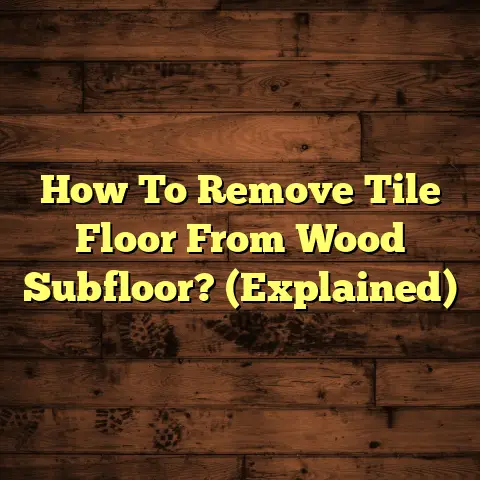Restoring Old Wood Floors? (1 Mistake Costs!)
(1 Mistake Costs!)
Ever walked into a room and been completely floored (pun intended!) by the beauty of the wood floors?That warm, inviting glow? Yeah, that’s what we’re after! The good news is, you might already have that potential hiding beneath your feet.
A quick win? Properly cleaning and polishing those old wood floors. You’d be surprised how much of a difference it makes without a full-blown restoration.
Let’s dive in and unlock the secrets to bringing those old wood floors back to life!
Section 1: Understanding the Importance of Restoration
1.1 Why Bother Restoring Old Wood Floors?
Okay, let’s get real. Why not just rip them out and put in something new? Well, old wood floors have character. They tell a story. They’re a piece of history!
Think about the craftsmanship that went into laying those floors decades (or even centuries!) ago. You can’t just buy that kind of history at a big box store.
From an aesthetic point, wood floors bring warmth, depth, and a timeless elegance to any space.
They’re like a good leather jacket – they only get better with age, as long as you take care of them.
1.2 The Eco-Friendly Choice
Did you know restoring your wood floors is actually good for the planet?
Think about it: ripping out old floors means sending all that material to a landfill.
Restoring, on the other hand, preserves natural resources and reduces waste. It’s the ultimate in upcycling!
Plus, wood is a renewable resource. By extending the life of your existing floors, you’re contributing to a more sustainable future.
1.3 Wood Floor Longevity: The Stats Don’t Lie
How long can properly maintained wood floors last? We’re talking generations. I’ve seen original hardwood floors in homes over 100 years old!
According to the National Wood Flooring Association (NWFA), a properly installed and maintained hardwood floor can last for 100+ years. That’s a pretty solid investment, right?
Think about that compared to carpet (which needs replacing every 5-10 years) or even laminate (which might last 10-20 years).
Wood floors are the marathon runners of the flooring world.
Section 2: Common Problems with Old Wood Floors
2.1 The Usual Suspects: Scratches, Dents, and Fading
Okay, so your floors aren’t perfect. That’s okay! Scratches, dents, fading – they’re all part of the aging process.
These imperfections can actually add character, but sometimes they just look… sad.
Scratches are usually caused by pets, furniture being dragged, or just plain old foot traffic.
Dents can come from dropped objects or heavy furniture legs.
Fading is usually caused by sunlight exposure. Those UV rays are brutal!
2.2 Moisture: Wood’s Arch-Nemesis
Moisture is the biggest enemy of wood floors. I cannot stress this enough. Water damage can lead to warping, cupping (where the edges of the boards rise up), and even rot.
Think leaky pipes, overflowing toilets, or even just excessive humidity.
Over time, this can weaken the structural integrity of the floor and create a breeding ground for mold and mildew. Yuck!
Always address water issues immediately to prevent long-term damage.
2.3 Cleaning Mistakes That Can Ruin Your Floors
Believe it or not, the wrong cleaning products can actually damage your wood floors.
Harsh chemicals, abrasive cleaners, and even excessive water can strip the finish, dull the shine, and leave your floors looking worse than before.
Avoid using vinegar, ammonia, or bleach on wood floors. These can break down the finish and cause discoloration.
Always use a pH-neutral cleaner specifically designed for wood floors.
Section 3: The Step-by-Step Restoration Process
3.1 Preparation: Setting the Stage for Success
Before you even think about touching your floors, you need to prep the area.
This means clearing all furniture, rugs, and other obstructions. Protect your baseboards and walls with painter’s tape.
Ventilation is key! Open windows and doors to ensure proper airflow, especially if you’re using any chemicals.
Tools and Materials Checklist:
- Painter’s tape
- Drop cloths or plastic sheeting
- Wood floor cleaner
- Buckets
- Mops (microfiber is best)
- Sandpaper (various grits)
- Sanding machine (drum or orbital)
- Wood filler (for repairs)
- Wood stain (optional)
- Wood floor finish (oil-based or water-based)
- Applicator pads or brushes
- Safety glasses
- Dust mask or respirator
3.2 Cleaning: Getting Down and Dirty (But Carefully!)
The first step in any restoration project is thorough cleaning. You need to remove all dirt, grime, and old wax buildup.
Start by sweeping or vacuuming the floors to remove loose debris.
Then, use a wood floor cleaner and a damp mop to clean the surface.
Be careful not to saturate the floors with water. You want the mop to be damp, not dripping wet.
Rinse the mop frequently in a separate bucket of clean water.
Allow the floors to dry completely before moving on to the next step.
3.3 Repairing Damage: Filling in the Gaps
Now it’s time to address any scratches, dents, or other minor damage.
For shallow scratches, you can often buff them out with fine-grit sandpaper.
For deeper scratches or dents, you’ll need to use wood filler.
Apply the wood filler to the damaged area, making sure to overfill it slightly.
Allow the filler to dry completely, then sand it smooth with fine-grit sandpaper.
If you’re planning to stain the floors, you may need to apply a wood conditioner to the filled areas to ensure even stain absorption.
When to Call a Pro: If you have extensive damage, such as warped boards or water damage, it’s best to call in a professional.
They have the expertise and equipment to handle more complex repairs.
3.4 Refinishing: The Grand Finale
This is where the magic happens! Refinishing involves sanding down the old finish and applying a new one.
Sanding:
This is the most important (and often the most intimidating) part of the process.
You’ll need a sanding machine (either a drum sander or an orbital sander) and various grits of sandpaper.
Start with a coarse grit (like 36-grit) to remove the old finish.
Then, gradually work your way up to finer grits (like 80-grit and 120-grit) to smooth the surface.
Be sure to sand in the direction of the wood grain.
Vacuum frequently to remove dust.
Choosing a Finish:
There are two main types of wood floor finishes: oil-based and water-based.
-
Oil-based finishes are more durable and offer a richer, warmer tone. They also tend to be more resistant to scratches and scuffs. However, they have a strong odor and take longer to dry.
-
Water-based finishes are more environmentally friendly and have a lower odor. They also dry faster than oil-based finishes. However, they may not be as durable or offer the same depth of color.
Applying the Finish:
Once the floors are sanded and clean, you can apply the finish.
Use an applicator pad or brush to apply a thin, even coat of finish.
Allow the finish to dry completely according to the manufacturer’s instructions.
Apply additional coats as needed, sanding lightly between coats.
Drying Times: Drying times vary depending on the type of finish and the environmental conditions.
Always follow the manufacturer’s instructions.
Section 4: The Cost of Mistakes in Restoration
4.1 The Cardinal Sin: Skipping the Sanding Process
Okay, here’s the big one. The one mistake that can cost you serious money and heartache: skipping the sanding process.
I’ve seen it happen so many times. Homeowners think they can save time and effort by simply applying a new finish over the old one.
Big mistake!
Without sanding, the new finish won’t adhere properly. It will peel, chip, and wear unevenly.
You’ll end up with a patchy, unattractive floor that needs to be refinished again much sooner than it should.
Real-Life Horror Story: I once had a client who tried to refinish their floors themselves without sanding.
They ended up with a finish that looked like orange peel and started peeling within a few months.
They had to hire me to come in and completely redo the job, which cost them twice as much as it would have if they had done it right the first time.
Don’t let this happen to you! Sanding is essential for a successful restoration.
4.2 Other Common Mistakes to Avoid
-
Using the wrong cleaning products: As I mentioned earlier, harsh chemicals can damage your floors. Always use a pH-neutral cleaner specifically designed for wood floors.
-
Neglecting to acclimate the wood: If you’re installing new wood flooring, it’s crucial to acclimate the wood to the environment before installation. This means allowing the wood to sit in the room for several days to adjust to the temperature and humidity levels. Failing to do so can lead to warping and cracking.
-
Applying too much finish: Applying too much finish can result in drips, runs, and an uneven surface. Always apply thin, even coats.
-
Ignoring water damage: As I said, moisture is the enemy. Address water issues immediately to prevent long-term damage.
-
Not wearing proper safety gear: Sanding creates a lot of dust, which can be harmful to your lungs. Always wear a dust mask or respirator when sanding.
Section 5: Maintenance Tips for Long-Lasting Results
5.1 Regular Cleaning is Key
The best way to keep your restored wood floors looking their best is to clean them regularly.
Sweep or vacuum frequently to remove loose debris.
Use a damp mop and a wood floor cleaner to clean the surface.
Avoid using excessive water.
5.2 Protective Measures
-
Area rugs: Place area rugs in high-traffic areas to protect the floors from wear and tear.
-
Furniture pads: Use furniture pads under the legs of your furniture to prevent scratches and dents.
-
Humidity control: Maintain a consistent humidity level in your home to prevent warping and cracking. A dehumidifier can help in humid climates.
5.3 Periodic Professional Maintenance
Consider hiring a professional flooring contractor to perform periodic maintenance on your wood floors.
They can buff and recoat the finish to keep it looking its best.
They can also identify and address any potential problems before they become major issues.
Conclusion: The Payoff of Restoration
Restoring old wood floors is an investment that pays off in so many ways.
You’ll enhance the aesthetic appeal of your home, increase its value, and contribute to a more sustainable future.
Plus, you’ll get to enjoy the beauty and character of those original wood floors for years to come.
Just remember to avoid that one critical mistake: don’t skip the sanding process!
With a little effort and the right knowledge, you can transform your old wood floors into a stunning focal point of your home. So, are you ready to get started?





